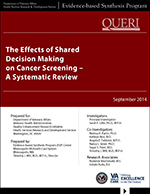
Principal Investigator: Sarah E. Lillie, Ph.D., M.P.H.
Co-Investigators: Melissa R. Partin, Ph.D. Kathryn Rice, M.D.
Angela E. Fabbrini, M.P.H. Nancy L. Greer, Ph.D. Sagar S. Patel, M.D. Timothy J. Wilt, M.D., M.P.H.
Download PDF: Complete Report, Executive Summary, Report, Appendices
Decisions about cancer screening have become increasingly complex. Patients must decide whether to get screened, which screening modality to use, and how often to undergo and when to stop screening. Some cancer screening decisions are considered "preference-sensitive," meaning that, due to closely-balanced benefits and harms, the "right" decision is in part dependent on an individual's values and preferences for particular outcomes. Most organizations publishing clinical practice guidelines for cancer screening now recommend that preference-sensitive cancer screening decisions be made individually, using a process that considers the available evidence on the benefits and harms of particular options, and incorporates patient values and preferences relevant to those options. This approach is sometimes referred to as shared decision making (SDM). The goal of SDM interventions is to facilitate this approach. Adjuncts for the usual counseling for specific decisions, SDM interventions may include: (1) tools to help patients comprehend information about the risks and benefits of options, clarify their personal values related to these options, and participate in decisions consistent with these values and preferences (sometimes referred to as "decision aids") and (2) other interventions to prepare health care providers and/or systems to support this process. SDM interventions differ from many health-related interventions in that they primarily seek to elicit and support patient values and preferences in making health care-related decisions rather than to promote a particular health care strategy per se.
In this review we examine the effects of SDM interventions for cancer screening in adults on constructs from the Ottawa Decision Support Framework, a commonly-used theoretical model of decision making. We examined the constructs of Decision Quality, Decision Impact, and, for studies reporting those outcomes, Decision Action. Decision Quality includes knowledge, values clarity (patients' clarity of their personal values regarding the risks and benefits of decision options), and the patients' participatory role in decision making. Decision Impact includes decisional conflict (personal uncertainty about which course of action to take), use of services (eg, consultation length), and satisfaction with the decision. Decision Action includes screening intention and behavior. The ideal SDM intervention would enhance Decision Quality (ie, increase knowledge and values clarity) and Impact (ie, increase satisfaction, reduce decision conflict, and have minimal impact on service utilization). The desired impact on Decision Action depends on the screening decision. For decisions about how to screen (such as colorectal cancer screening), the ideal SDM intervention would exert the desired effects on Decision Quality and Impact without reducing measures of Decision Action such as screening intention and behavior. For decisions about whether to screen (such as breast, cervical, and prostate cancer in some age groups and risk categories), the goal is to facilitate personalized decision making based on values and preferences. Hence, there are no desired effects on Decision Action per se in this context. We examine patient, provider, system, and multi-level SDM interventions, and therefore do not restrict this review to the most commonly employed SDM intervention of patient-directed decision aids.
Key Question 1: In adults, what are the effects of SDM interventions for cancer screening on:
Key Question 1a: Are there differential effects of the interventions based on:
Key Question 2: Within the included studies, what is the receptivity to SDM interventions for cancer screening for:
Key Question 3: Within the included studies, what are the resources required to implement a SDM intervention for cancer screening?